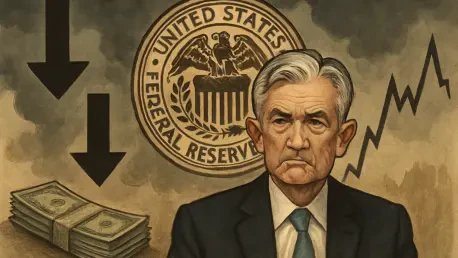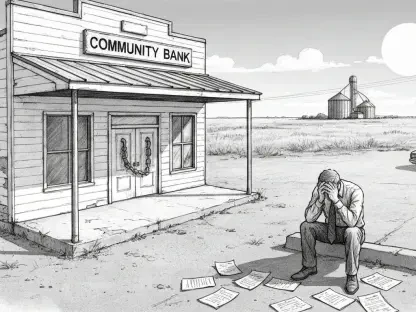The Federal Reserve stands at a critical juncture, wrestling with an economy that refuses to fit neatly into any predictable pattern, while inflation hovers stubbornly above the target of 2% and job growth slows, leaving policymakers to ponder whether to ease rates or stand firm. This delicate balance has sparked intense debate among economic leaders, with implications that ripple across national and global markets. This roundup gathers insights from various perspectives within and around the Fed, aiming to dissect the complexity of the current economic landscape and explore whether upcoming data might illuminate a path forward for monetary policy decisions.
Navigating Uncertainty: The Fed’s Complex Economic Crossroads
The Fed faces a challenging predicament, caught between persistent inflation and signs of a softening labor market. This tension directly challenges its dual mandate to stabilize prices while fostering full employment, a balance that influences everything from household budgets to international investor confidence. Policymakers are grappling with mixed signals that obscure the best course of action, creating a palpable sense of uncertainty in financial circles.
Delving deeper, the stakes of this dilemma extend beyond domestic borders, as Fed decisions often set the tone for global economic trends. The lack of clear direction has left businesses and consumers alike in a state of anticipation, unsure whether to brace for tighter conditions or expect relief through rate cuts. This roundup aims to synthesize diverse opinions on how the Fed might navigate these murky waters.
A key focus lies in the role of fresh economic data, which many hope will provide the clarity needed to resolve ongoing policy debates. By examining varied viewpoints from within the Fed and among market analysts, this discussion seeks to shed light on the broader implications for monetary strategy. The question remains whether new figures will cut through the fog or simply add to the confusion.
Decoding the Fed’s Policy Puzzle Amidst Mixed Signals
Inflation’s Persistent Shadow: A Barrier to Clear Action
Inflation continues to loom large over the Fed’s decision-making, stubbornly lingering above the desired 2% threshold. This stickiness has created hesitation among officials, with some wary of cutting rates too soon and risking a resurgence in price pressures. The concern is that premature easing could undo hard-won progress in curbing cost increases.
On the flip side, there’s growing evidence of consumer pushback against higher prices, which some policymakers see as a natural brake on inflation. Recent economic reports also point to sustained corporate earnings, though growth remains uneven across sectors. This patchwork of data fuels the argument that inflation might be taming itself, potentially justifying a more accommodative stance.
Within the Fed, the debate rages on, with factions split over the risks of action versus inaction. One group fears that maintaining tight policy could choke economic expansion, while another cautions against underestimating inflationary undercurrents. This division underscores the complexity of interpreting current trends without definitive data to tip the scales.
Employment’s Uneasy Balance: Stability or Warning Signs?
Turning to the labor market, job growth has decelerated, yet unemployment holds relatively steady, partly due to a shrinking labor supply. This apparent stability masks underlying contradictions that complicate the Fed’s assessment. While overall figures suggest balance, deeper cracks are visible in specific industries facing strain.
Contrasting signals emerge from corporate behavior, with many firms reporting a surplus of applicants for most positions, except in specialized trades. Meanwhile, high-profile layoffs at major companies in tech and retail hint at distress in targeted sectors. These disparities create a puzzle for policymakers trying to gauge the true health of employment.
The risk of overreacting to softening job data weighs heavily, as does the potential to miss an opportunity to prevent a steeper downturn. Some argue that preemptive rate cuts could cushion vulnerable sectors, while others caution that such moves might overheat other parts of the economy. Striking the right balance remains an elusive goal amidst these mixed indicators.
Data Drought: Steering Policy in the Dark
A significant hurdle for the Fed is the current scarcity of comprehensive economic data, leaving policymakers to navigate with limited visibility. This gap, exacerbated by delays in official releases, has been likened to steering through uncertainty without clear guidance. The absence of fresh figures hinders the ability to make informed choices.
Regional disparities further cloud the picture, with some areas showing resilience while others falter under economic pressure. The hope is that forthcoming data will offer a sharper lens on these variations, potentially reshaping expectations for policy direction. However, there’s skepticism about whether new information will fully resolve the ambiguity.
Even with updated statistics, mixed signals may persist, challenging the notion that data alone can provide a definitive answer. Analysts point out that interpreting these numbers often involves subjective judgment, especially in a landscape of uneven recovery. The Fed’s reliance on both quantitative metrics and qualitative feedback will likely remain crucial in this context.
Divided Voices: The Fed’s Internal Tug-of-War
Within the Fed, a lack of consensus adds another layer of complexity, with opinions split between advocating for rate cuts to bolster jobs and urging caution to tame inflation. Some officials adopt a neutral stance, recognizing valid points on both sides without committing to a specific path. This internal discord reflects the broader uncertainty gripping economic strategy.
Market sentiment mirrors this division, with investors nearly evenly divided on the likelihood of a rate cut at the next meeting. Expectations hover between a potential quarter-point reduction and a pause in adjustments, highlighting the unpredictability of the Fed’s next move. Such indecision could erode confidence if prolonged, some market watchers warn.
The value of patience, as emphasized by certain Fed voices, lies in waiting for clearer economic indicators before acting. Yet, there’s concern that extended hesitation might signal weakness to markets, potentially amplifying volatility. Balancing the need for deliberate decision-making with the demand for decisive action remains a tightrope walk for the central bank.
Key Insights: What Experts Reveal About the Fed’s Path Forward
Synthesizing the range of perspectives, the economy’s delicate equilibrium stands out as a central theme, with inflation and employment pulling in opposite directions. Internal divisions within the Fed highlight the challenge of aligning on a unified strategy, while the anticipation of new data emerges as a potential turning point. These insights underscore the intricate dance of monetary policy in turbulent times.
For businesses and investors, navigating this uncertainty requires a focus on sector-specific trends rather than broad economic forecasts. Flexibility in planning, such as adjusting to potential rate shifts, can help mitigate risks during this ambiguous period. Staying attuned to localized economic conditions also offers a practical edge in decision-making.
To remain informed, stakeholders are encouraged to monitor upcoming economic releases and Fed communications closely. These sources often provide subtle hints about future policy directions, even amidst conflicting signals. Keeping a pulse on such updates ensures a proactive stance in an unpredictable environment.
Looking Ahead: Reflections on the Fed’s Economic Challenges
Reflecting on the discussions that unfolded, the Fed’s struggle to balance competing pressures became a focal point for analysts and policymakers alike. The persistent inflation and softening job market painted a picture of an economy in limbo, with internal disagreements adding to the sense of indecision. The hope pinned on incoming data as a clarifying force captured the cautious optimism of that moment.
Moving forward, a practical step for stakeholders involves preparing for multiple scenarios, whether the Fed opts for rate adjustments or maintains its current stance. Businesses can adapt by stress-testing financial plans against potential policy shifts, while investors might seek diversified strategies to weather volatility. These actions lay the groundwork for resilience in an uncertain landscape.
As a final consideration, exploring deeper into sector-specific data offers a pathway to anticipate Fed moves more accurately. Engaging with regional economic reports and industry trends provides additional layers of insight, helping to navigate the broader ambiguity. This proactive approach empowers decision-makers to stay ahead of the curve in a shifting economic terrain.









